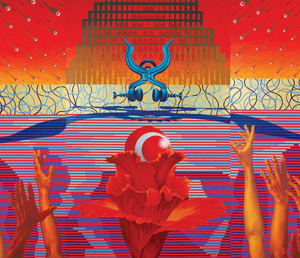

JUST OPENED, “Roots in the Air, Branches Below: Modern and Contemporary Art From India” at the San Jose Museum of Art serves as a stimulating introduction to major figures and themes of Indian art from 1947 to the present day, work rarely exhibited in the United States.
Through some 50 paintings, drawings and sculptures drawn from 11 Bay Area collections, SJMA endeavors to represent the dizzying scope of fine art of the modern era in that subcontinent whose cultural roots are millennia-deep and immeasurably diverse.
Almost inconceivably with such a small representation of works, curator Kristen Evangelista succeeds in illuminating parallels, consistencies and influences in a way that broadens understanding of this complex culture and its place in the global art community.
The title is a quote from the Bhagavad-Gita: “Roots in the air, and branches below. The Tree of Life is unchanging.” Indeed the exhibit shows that the examination of roots (regionalism, nationalism, romanticized view of indigenous cultures) and branches (globalization, the Indian diaspora) would seem to have been a preoccupation of Indian art throughout the last century.
The works are divided into two eras: Modern (post-colonial painters who gained prominence from the 1940s) and Contemporary (artists arising within the last 20 years).
In the Modern gallery, we see that Indian artists had already experimented with abstraction and Cubism until the nationalism fueling the partition from British rule in 1947 inspired a return to traditional and folk-art themes. Many artists later re-engaged in the international art world while remaining rooted in Indian tradition.
Ganesh Pyne is represented by a small 1968 tempura, The Dancer, which refers in scale and subject to the distinctive folk art of the Bengali region while it recalls in its ambiguity and composition world artists like Paul Klee. Pyne had been a watercolorist with the Bengal School, one of the groups that sought a true “indigenous” Indian art form.
The Bengal School at times exalted the flat court-painting styles of India’s Mughal era or, embracing Pan-Asianism, Japanese brush techniques. Five paintings by “the Picasso of India,” Maqbool Fida Husain, embody such diverse influences. His plunging Horses are evocative calligraphic expressions as reminiscent of Japanese brush painting as they are of expressionists like Kline. A painting from his Mother Teresa series glorifies village life as much as it comments on history.
Jamini Roy was one of the artists who rejected Western influences and turned to traditional Bengal folk and religious arts, especially the patua, or scroll forms. His paintings live simultaneously in past and present, their dynamic composition, geometric simplification and sure, beefy lines that separate colors in a bold, limited palette could at once be mistaken for Byzantine or Pop art, though the subject is unmistakably Indian. The Modern gallery is turbulent with world influences played out primarily in figurative paintings often grounded in mythological or social commentary.
The Contemporary gallery shows some 30 works by artists in India or of Indian heritage. No predominant style is evident; globalization has stripped away regional schools or styles. The figure within a narrative context continues to predominate; many works still draw from mythology, as in Vinood Balak’s Vishnu With Bonsai, or Surendran Nair’s Neti, Neti: The Doctrine of the Forest.
Social issues are diversely addressed, as in the ironic Universal Recipient—8 by Jitish Kallat, which uses a deliberately crude poster style, or the massive, slick colorist triptych Induced Epidemic, by Ashutosh Bhardwaj, which is mechanically precise and highly dramatic. Alexis Kersey’s ironic Lucky, Lucky, Lucky conjures Renaissance Mother and Child altarpieces, but framed in tantric skulls. Irony predominates throughout as an attitude—a global condition.
“Roots in the Air” shows that, in this continent that has been a crossroads, a trade route, a birthplace of world religions, a continuously evolving bastion of high culture for over a millennium, the roots are wide and the branches ever-flowering.
ROOTS IN THE AIR, BRANCHES BELOW
Through Sept. 4


